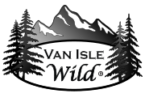Having been raised with the salty breeze of the Pacific in most memories I have, I’m sure that by now the Pacific air is so much a part of me that it is essential to my survival. One of my fondest memories as a child was discovering the diverse life forms in the tidal pools in East Sooke Park. Little did I know, one of the most important life forms on the Vancouver Island coast that was laying all over the beaches is so complex that scientists have only begun to understand it. Kelp is one of the essential parts of the Pacific ecosystem for so many reasons.
We all know the slimy brown piles washed ashore especially following a good storm. You may have seen the brown balls on the ends; these are called fronds and are actually filled with gas to keep them afloat. The brown pigment of kelp is a powerful antioxidant and it’s slime is called fucoidan, which is thought to prevent diabetes, stroke, hypertension and other diseases associated with aging. The element of Iodine was first discovered in kelp, and the concentration is over 20,000 times the levels as in seawater.
Kelp is not a plant, but considered a heterokont, because it is not made up of more than one uniquely differentiated tissue, and it does not have roots. They are large brown algae seaweed with over 30 different genera in the Laminariales order. Kelp grows in biodiverse underwater “forests” often called kelp forests, in shallow ocean water and is suspected to have been on the planet for somewhere between 5 and 23 million years. Some species make up the underwater forest floor, and other taller kelp creates the forest ‘canopy’ growing up to 50 meters tall, like giant and bull kelp.
The many varieties of kelp, growing in harmony to create these diverse underwater forests, provide incredible habitat and food for many different life forms including fish invertebrate and marine mammals including starfish, cormorants, blue heron, whales and shore birds. Kelp also serves as a host for herring to lay their eggs and keep them safe from predators. Like trees in a forest, these kelp forests provide food and shelter. They are also vulnerable to storms and drastic weather events like land forests, as the water currents will break the kelp and wash it up onto shore leaving the underwater forests to regrow and repair themselves in the spring.
Part of the balance of nature is demonstrated within these kelp forests. Sea urchins eat a lot of kelp, and sea otters enjoy eating the sea urchins. If sea otter populations decline, the urchins get out of balance and soon entire kelp forests are decimated. During the fur trade, sea otter populations were at terribly low numbers, and sea urchin numbers increased which had a domino effect by depleting kelp populations, and the sea life that relied on kelp. Eventually sea otters were added to the Species at Risk list, and their protection exponentially multiplied their numbers, the sea urchins declined and new kelp forests started to thrive.
Even more amazing is the potential kelp has to assist with the mitigation of carbon and preventing of further damage to our atmosphere. According to the Nature Conservancy of Canada, “while forests get a lot of attention when it comes to capturing carbon, coastal ecosystems have an incredible capacity to mitigate the effects of climate change. They’re also not susceptible to wildfires like land-based forests, given their underwater habitat. In fact, coastal ecosystems “can sequester up to 20 times more carbon per acre than land forests,” as stated by scientists at Harvard University”
In ideal conditions, large varieties of kelp can grow up to 18 inches per day, up to 150 feet underwater and through photosynthesis they are capable of sequestering up to 200 million tons of carbon dioxide per year. Once the carbon is secured in the kelp, it is either harvested for use, or it will sink to the ocean floor and be stored in ocean sediments. Scientists around the world are recommending industrial sized kelp farms in recognition of the speed and effectiveness of kelp in capturing carbon. This would enable carbon to become trapped in the ocean floor and buried for thousands of years, greatly reducing climate change and drastically affecting the current carbon release into our atmosphere.
Kelp was always one of those strange things I stepped over at the beach and never really thought much about. Sometimes you would see children trying to have sword fights or chasing each other with large strands of oozing brown seaweed. When we take the time to really look at the benefits of one part of nature we can really see how much each piece of the puzzle is so integral to the functioning of the various ecosystems. Everything has a purpose and how incredible to think that life that has been here for millions of years may possibly be able to help us in our most desperate environmental times. Nature never ceases to amaze me.
By Angela Hicke – Van Isle Wild
All Rights Reserved – © Copyright 2021

